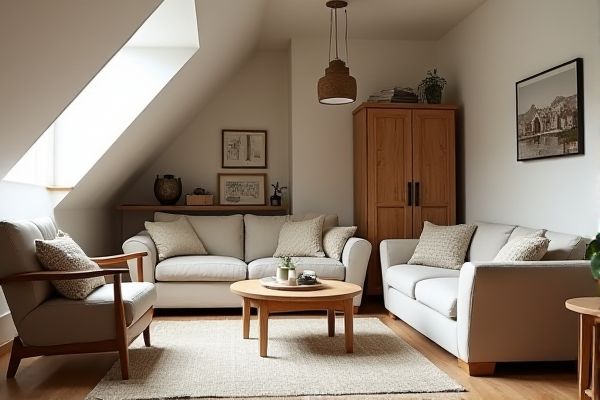
Choosing low-profile furniture for an attic maximizes space by creating an open, airy feel and preventing the room from feeling cramped under sloped ceilings, while tall furniture can provide extra storage but may overwhelm the limited vertical space and make the area appear smaller. Discover how to balance style and functionality with the right furniture choices to optimize your attic's unique layout in the rest of this article.
Table of Comparison
| Feature | Low-Profile Furniture | Tall Furniture (Attic) |
|---|---|---|
| Height | Short, fits under sloped ceilings | Tall, requires high ceilings |
| Space Efficiency | Maximizes usable floor space | Utilizes vertical storage |
| Suitability | Ideal for low-ceiling attics | Better for spacious attic rooms |
| Visual Impact | Creates open, airy feel | Can make space feel crowded |
| Storage Capacity | Limited height storage | Higher storage volume |
| Installation | Easy to move and rearrange | May require assembly or anchoring |
Introduction to Attic Furniture Choices
Attic furniture choices hinge on maximizing limited space and accommodating sloped ceilings, making low-profile furniture ideal for compact, low-clearance areas to enhance openness and functionality. Tall furniture can create a sense of vertical storage but may not fit well under attic eaves, often forcing awkward placements and reducing usable volume. Selecting low-profile pieces like short bookcases, low dressers, and platform beds optimizes attic layouts by aligning with roof angles and preserving headroom.
Understanding Low-Profile Furniture
Low-profile furniture is designed with a minimal height, making it ideal for attic spaces with limited headroom by maximizing usable space without overcrowding. This type of furniture promotes an open, airy feel while providing functional storage and seating that complements sloped ceilings. Choosing low-profile pieces helps maintain your attic's spaciousness and enhances overall comfort by fitting seamlessly into tight areas.
The Appeal of Tall Furniture
Tall furniture maximizes attic space by providing ample vertical storage, which is ideal for rooms with sloped ceilings and limited floor area. Its design enhances organization by accommodating larger items and stacking options, making your attic both functional and aesthetically pleasing. By drawing the eye upward, tall furniture creates a sense of height and openness, transforming cramped attic spaces into inviting environments.
Space Constraints in Attic Rooms
Low-profile furniture maximizes usable space in attic rooms by fitting seamlessly under sloped ceilings, allowing for better floor area utilization and easier movement. Tall furniture often faces restrictions due to limited vertical clearance, reducing functional placement options and creating cramped conditions. Choosing compact, low-profile pieces enhances spatial efficiency and maintains an open, airy feel despite attic space constraints.
Maximizing Headspace with Low-Profile Designs
Low-profile furniture is ideal for attics as it maximizes headspace by staying closer to the floor, reducing the risk of bumping into low ceilings. Tall furniture in an attic can make the space feel cramped and limit movement, while low-profile designs create an open and airy atmosphere. Choosing low-profile pieces allows you to fully utilize your attic's vertical space without sacrificing comfort or functionality.
Storage Solutions: Low-Profile vs Tall Options
Low-profile furniture maximizes attic space by fitting under sloped ceilings and offering discreet storage without overwhelming your room, while tall furniture provides vertical storage capacity ideal for maximizing limited floor area. Choosing low-profile options helps maintain an open, airy atmosphere and enhances accessibility to stored items, whereas tall furniture optimizes storage for bulkier or less frequently used belongings. Your choice depends on attic dimensions and storage needs, balancing ease of access against maximizing available volume.
Aesthetic Impact in Sloped Ceilings
Low-profile furniture enhances the aesthetic appeal of attic spaces with sloped ceilings by maintaining an open, airy feel and preventing visual clutter, which complements the room's unique angles. Tall furniture often disrupts the flow, making the space feel cramped and overshadowing architectural features like exposed beams or dormer windows. Choosing appropriately scaled pieces tailored to the attic's dimensions preserves both functionality and style, optimizing the overall visual harmony.
Comfort and Functionality Considerations
Low-profile furniture in attics enhances comfort by maximizing headroom and creating a spacious feel, essential for rooms with sloped ceilings. Tall furniture, while offering more storage capacity, can reduce usable space and hinder movement, potentially causing discomfort in confined attic areas. Balancing functionality with spatial constraints ensures that furniture choices in attics optimize both comfort and practical use.
Interior Design Tips for Attic Furnishing
Low-profile furniture enhances attic spaces by maximizing headroom and creating an airy atmosphere, ideal for sloped ceilings and compact layouts. Tall furniture can overwhelm small attic rooms, restricting movement and visual flow, but smart use of vertical storage like built-in shelves optimizes space without crowding. Incorporate multifunctional pieces with light colors and minimalist design to maintain brightness and openness, crucial factors in attic interior design.
Choosing the Right Furniture for Your Attic
Selecting low-profile furniture for your attic maximizes space and maintains an open, airy feel in rooms with sloped ceilings or limited height. Tall furniture can create storage opportunities but may overwhelm the space and reduce headroom, making the area feel cramped. Prioritize pieces with shorter heights and multifunctional storage to enhance usability while preserving the attic's unique spatial dynamics.
 homyna.com
homyna.com